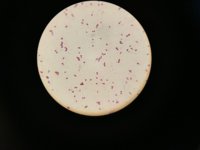GreenDragon
Well-Known Member
I’ve recently become a little enamored with Burley from playing around with new blends. I like the strength and depth of flavor it brings, but am still learning how to balence it’s alkaline / dry / back of the throat bitting nature. As I was mulling this over the other weekend sipping on a home brew beer I suddenly had the following train of thought: You typically blend some sort of acid with Burley to soften it, .... beer is acidic, ... try making a fermented Burley!
So, I carefully decanted the plug of beer yeast from the bottom of my bottle, mixed it with a 1/2 cup of water and a tablespoon of brown sugar, shook it up well and poured it into a quart mason jar. I then added dry whole leaf burley leaves to the jar until full and added a barely tightened lid. Sure enough within a day I had a bubbling culture of yeast in the jar. I also learned that fermenting tobacco leaves become fizzy and float allowing the juice to be forced out of the jar making a huge @“&$ mess. Note - add a follower to keep the leaves submerged.
After two weeks the fermentation was completed and I took out the leaves and dryed them on a sheet pan. I then filled two virgin cob pipes, one with reg burley and one with beerique. The straight Burley was as expected; harsh and bitey. The beerique, on the other hand, was perfectly smooth and a very enjoyable smoke! It also had a slightly different flavor, which was pleasant, but I don’t know how to describe. I used a Pilsner yeast because that’s what I was drinking at the moment, and so I liken the flavor to that kind of beer. My next attempt will be with an ale yeast as I would love to develop more fruity flavors like those beers. (I did not add any hops, so there is no “beer” taste or aroma, Its more of a bready fermented smell.)
A word of warning - it’s still burley, and like it’s cousin Perique, packs a punch that will quickly sneak up on you!
I consider this experiment a success and look forward to playing with my “beerique” in some new blends.
So, I carefully decanted the plug of beer yeast from the bottom of my bottle, mixed it with a 1/2 cup of water and a tablespoon of brown sugar, shook it up well and poured it into a quart mason jar. I then added dry whole leaf burley leaves to the jar until full and added a barely tightened lid. Sure enough within a day I had a bubbling culture of yeast in the jar. I also learned that fermenting tobacco leaves become fizzy and float allowing the juice to be forced out of the jar making a huge @“&$ mess. Note - add a follower to keep the leaves submerged.
After two weeks the fermentation was completed and I took out the leaves and dryed them on a sheet pan. I then filled two virgin cob pipes, one with reg burley and one with beerique. The straight Burley was as expected; harsh and bitey. The beerique, on the other hand, was perfectly smooth and a very enjoyable smoke! It also had a slightly different flavor, which was pleasant, but I don’t know how to describe. I used a Pilsner yeast because that’s what I was drinking at the moment, and so I liken the flavor to that kind of beer. My next attempt will be with an ale yeast as I would love to develop more fruity flavors like those beers. (I did not add any hops, so there is no “beer” taste or aroma, Its more of a bready fermented smell.)
A word of warning - it’s still burley, and like it’s cousin Perique, packs a punch that will quickly sneak up on you!
I consider this experiment a success and look forward to playing with my “beerique” in some new blends.






